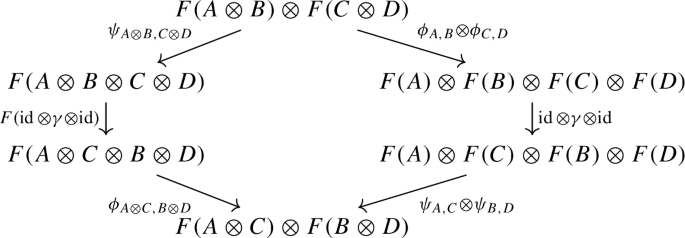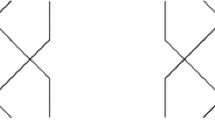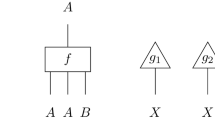Abstract
Originally introduced in the context of the algebraic approach to term graph rewriting, the notion of gs-monoidal category has surfaced a few times under different monikers in the last decades. They can be thought of as symmetric monoidal categories whose arrows are generalised relations, with enough structure to talk about domains and partial functions, but less structure than cartesian bicategories. The aim of this paper is threefold. The first goal is to extend the original definition of gs-monoidality by enriching it with a preorder on arrows, giving rise to what we call oplax cartesian categories. Second, we show that (preorder-enriched) gs-monoidal categories naturally arise both as Kleisli categories and as span categories, and the relation between the resulting formalisms is explored. Finally, we present two theorems concerning Yoneda embeddings on the one hand and functorial completeness on the other, the latter inducing a completeness result also for lax functors from oplax cartesian categories to \(\textbf{Rel}\).
Similar content being viewed by others
Data Availability
Not applicable.
Notes
Viewing a preorder-enriched category as a 2-category, the inequalities state that the families of arrows \(\nabla _A\) and \(!_A\) are the components of an oplax natural transformation. The connection between these inequalities and rewriting is explored in [18].
The use of “colax” here refers to the direction of the 2-cell, namely from \(F(\nabla _A)\) to \(\psi _{A,A}\circ \nabla _{FA}\).
See [26, Corollary 3.2] where this was previously used for Markov categories.
We expect this to be known, but we have not found a precise reference. The closest that we know of is [33, Proposition 28] which shows the analogous statement for the forgetful functor from the Eilenberg-Moore category \(\mathcal {A}^T\), but under additional assumptions on T needed to make \(\mathcal {A}^T\) monoidal in the first place.
Even if that reference just considers spans in \(\textbf{Set}\), the proofs work for any category with finite limits.
Strict unitality could also be assumed, but that choice would make some diagrams potentially confusing.
References
Aguiar, M., Mahajan, S.: Monoidal Functors, Species and Hopf Algebras CRM Monograph Series, p. 784. American Mathematical Society, Providence, RI (2010)
Alvarez-Picallo, M., Ghica, D., Sprunger, D., Zanasi, F.: Rewriting for monoidal closed categories. In: Felty, A. (ed.) FSCD 2022. LIPIcs, vol. 228, pp. 29–12920. Schloss Dagstuhl - Leibniz-Zentrum für Informatik, Wadern (2022)
Bonchi, F., Pavlovic, D., Sobociński, P.: Functorial semantics for relational theories. CoRR abs/1711.08699 (2017)
Bonchi, F., Seeber, J., Sobociński, P.: Graphical conjunctive queries. In: Ghica, D., Jung, A. (eds.) CSL 2018. LIPIcs, pp. 13–11323. Schloss Dagstuhl-Leibniz-Zentrum für Informatik, Wadern (2018)
Bonchi, F., Sobociński, P., Zanasi, F.: A survey of compositional signal flow theory. In: Goedicke, M., Neuhold, E.J., Rannenberg, K. (eds.) Advancing Research in Information and Communication Technology. IFIP AICT, vol. 600, pp. 29–56. Springer, Cham (2021)
Bonchi, F., Gadducci, F., Kissinger, A., Sobociński, P., Zanasi, F.: String diagram rewrite theory I: rewriting with Frobenius structure. J. ACM 69(2), 14–11458 (2022)
Borceux, F.: Handbook of categorical algebra 2: categories and structures. In: Encyclopedia of Mathematics and its Applications. Cambridge University Press, Cambridge (1994)
Bruni, R., Gadducci, F.: Some algebraic laws for spans (and their connections with multirelations). In: Kahl, W., Parnas, D.L., Schmidt, G. (eds.) RelMiS 2001. ENTCS, pp. 175–193. Elsevier, Amsterdam (2003)
Carboni, A.: Bicategories of partial maps. Cah. Topol. Géométr. Différ. Catég. 28(2), 111–126 (1987)
Carboni, A., Walters, R.F.C.: Cartesian bicategories I. J. Pure Appl. Algebra 49(1), 11–32 (1987)
Carboni, A., Kelly, G.M., Walters, R.F.C., Wood, R.J.: Cartesian bicategories II. Theory Appl. Categ. 19(6), 93–124 (2008)
Cho, K., Jacobs, B.: Disintegration and Bayesian inversion via string diagrams. Math. Struct. Comput. Sci. 29(7), 938–971 (2019)
Cockett, J.R.B., Lack, S.: Restriction categories I: categories of partial maps. Theor. Comput. Sci. 270(1), 223–259 (2002)
Cockett, J.R.B., Lack, S.: Restriction categories II: partial map classification. Theor. Comput. Sci. 294(1), 61–102 (2003)
Cockett, J.R.B., Lack, S.: Restriction categories III: colimits, partial limits and extensivity. Math. Struct. Comput. Sci. 17(4), 775–817 (2007)
Corradini, A., Gadducci, F.: A 2-categorical presentation of term graph rewriting. In: Moggi, E., Rosolini, G. (eds.) CTCS 1997. LNCS, pp. 87–105. Springer, Berlin (1997)
Corradini, A., Gadducci, F.: An algebraic presentation of term graphs, via gs-monoidal categories. Appl. Categ. Struct. 7, 299–331 (1999)
Corradini, A., Gadducci, F.: Rewriting on cyclic structures: equivalence between the operational and the categorical description. RAIRO Theor. Inform. Appl. Inform. Théor. Appl. 33(4–5), 467–493 (1999)
Corradini, A., Gadducci, F.: A functorial semantics for multi-algebras and partial algebras, with applications to syntax. Theor. Comput. Sci. 286, 293–322 (2002)
Corradini, A., Gadducci, F., Kahl, W., König, B.: In equational deduction as term graph rewriting. In: Mackie, I., Plump, D. (eds.) TERMGRAPH 2002. ENTCS, vol. 72, pp. 31–44. Elsevier, Amsterdam (2007)
Day, B.: On closed categories of functors. In: Reports of the Midwest Category Seminar, IV. Lecture Notes in Mathematics, vol. 137, pp. 1–38. Springer, Berlin (1970)
Day, B.J.: Construction of Biclosed Categories. University of New South Wales, Sydney (1970)
Fong, B., Spivak, D.: Regular and relational categories: revisiting ‘cartesian bicategories I’. CoRR abs/1909.00069 (2019)
Fong, B., Spivak, D.: Supplying bells and whistles in symmetric monoidal categories. CoRR abs/1908.02633 (2019)
Fox, T.: Coalgebras and cartesian categories. Commun. Algebra 4, 665–667 (1976)
Fritz, T.: A synthetic approach to Markov kernels, conditional independence and theorems on sufficient statistics. Adv. Math. 370, 107239 (2020)
Fritz, T., Perrone, P., Rezagholi, S.: Probability, valuations, hyperspace: three monads on top and the support as a morphism. Math. Struct. Comput. Sci. 31(8), 850–897 (2021)
Fritz, T., Gonda, T., Perrone, P., Rischel, E.F.: Representable Markov categories and comparison of statistical experiments in categorical probability. Theor. Comput. Sci. 961, 113896 (2023)
Gadducci, F.: On the Algebraic Approach to Concurrent Term Rewriting. University of Pisa, Pisa (1996)
Gadducci, F.: A term-graph syntax for algebras over multisets. In: Corradini, A., Montanari, U. (eds.) WADT 2008. LNCS, vol. 5486, pp. 152–165. Springer, Berlin, Heidelberg (2008)
Giry, M.: A categorical approach to probability theory. In: Banaschewski, B. (ed.) Categorical Aspects of Topology and Analysis Lecture Notes in Mathematics, vol. 915, pp. 68–85. Springer, Berlin-New York (1982)
Golubtsov, P.V.: Axiomatic description of categories of information transformers. Probl. Inf. Transm. 35(3), 259–274 (1999)
Guitart, R.: Tenseurs et machines. Cah. Topol. Géométr. Différ. 21(1), 5–62 (1980)
Heunen, C., Kammar, O., Staton, S., Yang, H.: A convenient category for higher-order probability theory. In: LICS 2017, p. 12. IEEE Press, Piscataway, NJ (2017)
Jacobs, B.: Semantics of weakening and contraction. Ann. Pure Appl. Log. 69(1), 73–106 (1994)
Jacobs, B.: From probability monads to commutative effectuses. J. Log. Algebr. Methods Program. 94, 200–237 (2018)
Kelly, G.M.: Basic concepts of enriched category theory. Repr. Theory Appl. Categ. 10, 1–136 (2005)
Kock, A.: Monads on symmetric monoidal closed categories. Arch. Math. 21, 1–10 (1970)
Kock, A.: Bilinearity and cartesian closed monads. Math. Scand. 29(2), 161–174 (1971)
Kock, A.: Strong functors and monoidal monads. Arch. Math. 23, 113–120 (1972)
Lambek, J., Scott, P.J.: Introduction to Higher Order Categorical Logic. Cambridge University Press, Cambridge (1986)
Lawvere, F.W.: Functorial semantics of algebraic theories. Proc. Natl. Acad. Sci. 50(5), 869–872 (1963)
MacLane, S., Moerdijk, I.: Sheaves in Geometry and Logic. A First Introduction to Topos Theory. Springer, New York (1992)
Makkai, M., Reyes, G.: First Order Categorical Logic. Lecture Notes in Mathematics, vol. 611. Springer, Berlin-New York (1977)
Mandell, M.A., May, J.P., Schwede, S., Shipley, B.: Model categories of diagram spectra. Proc. Lond. Math. Soc. 82(2), 441–512 (2001)
Moggi, E.: Computational lambda-calculus and monads. In: LICS 1989, pp. 14–23. IEEE Press, Piscataway, NJ, USA (1989)
Moggi, E.: Notions of computation and monads. Inf. Comput. 93(1), 55–92 (1991)
Robinson, E., Rosolini, G.: Categories of partial maps. Inf. Comput. 79(2), 95–130 (1988)
Selinger, P.: A survey of graphical languages for monoidal categories. In: Coecke, B. (ed.) New Structures for Physics. Lecture Notes in Physics, pp. 289–355. Springer, Heidelberg (2011)
Tanaka, M.: Pseudo-distributive laws and a unified framework for variable binding. The University of Edinburgh, Edinburgh (2004)
Funding
Tobias Fritz acknowledges funding by the Austrian Science Fund (FWF) through the project “P 35,992-N”. Andrea Corradini, Fabio Gadducci and Davide Trotta acknowledge funding by the Italian Ministry of Education, University and Research (MIUR) through the project PRIN 20228KXFN2 “STENDHAL”.
Author information
Authors and Affiliations
Contributions
TF, FG, DT and AC contributed equally to this work.
Corresponding author
Ethics declarations
Conflict of interest
The authors declare that they have no conflict of interest.
Additional information
Communicated by Ross Street.
Publisher's Note
Springer Nature remains neutral with regard to jurisdictional claims in published maps and institutional affiliations.
Appendices
Appendix A Lax/oplax/bilax Monoidal Functors
This section recalls the definitions of lax, colax, and bilax monoidal functors, see e.g. [1]. Throughout, \(\mathcal {C}\) and \(\mathcal {D}\) are symmetric monoidal categories with tensor functor \(\otimes \) and monoidal unit I, and we assume that \(\otimes \) strictly associates without loss of generality in order to keep the diagrams simple. Left and right unitors are denoted by \(\lambda \) and \(\rho \), respectively,Footnote 7 and braidings by \(\gamma \).
Definition A1
A functor \(F :\mathcal {C} \rightarrow \mathcal {D}\) is lax monoidal if it is equipped with a natural transformation
and an arrow \(\psi _0 :I \rightarrow F(I)\) such that the associativity diagrams

and the unitality diagrams commute

F is said to be lax symmetric monoidal if also the following diagram commutes

For example, if \(\mathcal {C}\) is the terminal monoidal category with only one object I and \({\text {id}}_I\) as the only arrow, then F is simply a monoid in \(\mathcal {D}\). We do not spell out the following dual version in full detail.
Definition A2
A functor \(F :\mathcal {C} \rightarrow \mathcal {D}\) is oplax monoidal if it is equipped with a natural transformation
and a map \(\phi _0 :F(I) \rightarrow I\) satisfying axioms dual to those in Definition A1. Similarly, an oplax symmetric monoidal functor is an oplax monoidal functor such that \(\phi \) commutes with the braiding \(\gamma \).
We also have the notion of strong symmetric monoidal functor, which is a lax symmetric monoidal functor with invertible structure arrows, or equivalently an oplax monoidal functor with invertible structure arrows; and that of strict symmetric monoidal functor, in which the structure arrows are identities.
A monoid and comonoid structure on an object in a symmetric monoidal category often interact in a nice way, either such that they form a bimonoid or a Frobenius monoid (and sometimes both). The following definition (see [1]) generalises the former notion to functors.
Definition A3
A functor \(F :\mathcal {C} \rightarrow \mathcal {D}\) is bilax monoidal if it is equipped with a lax monoidal structure \(\psi ,\psi _0\) and an oplax monoidal structure \(\phi ,\phi _0\) such that the following compatibility conditions hold
-
Braiding. The following diagram commutes

-
Unitality. The following diagrams commute

We also say that F is bilax symmetric monoidal if in addition both the lax and oplax structures are symmetric.
Appendix B Commutative Monads
A strength and a costrength for a monad on a monoidal category are structures relating the monad with the tensor product of the category at least in one direction. A monad equipped with a strength is called a strong monad. This notion was introduced by Kock in [40] as an alternative description of enriched monads. Strong monads have been successfully used in computer science, playing a fundamental role in Moggi’s theory of computation [46, 47].
We recall these concepts in the following definitions.
Definition B.1
A strong monad \((T,\mu ,\eta ,t)\) on a symmetric monoidal category \(\mathcal {C}\) is a monad \((T,\mu ,\eta )\) on \(\mathcal {C}\) together with a natural transformation
called strength, such that the following diagrams commute for all objects X, Y, Z of \(\mathcal {C}\)

Example B.2
The list monad \(T_{\textrm{list}} :\textbf{Set} \rightarrow \textbf{Set}\) is strong. Given two sets X and Y, the strength component
is given by the function assigning to an element \((x,[y_1,\dots ,y_m])) \) of \( X\times T_{\textrm{list}}(Y)\) the element \([(x,y_1),\dots ,(x,y_m)]\) of \( T_{\textrm{list}}(X\times Y)\).
In fact, any monad on the cartesian category \(\textbf{Set}\) is strong in a unique way, where the strength can be defined similarly to the strength of the list monad. We refer to [40] for more details.
Remark B.3
The braiding \(\gamma \) of \(\mathcal {C}\) let us define a costrength with components
given by
It satisfies axioms that are analogous to those of strength.
Definition B.4
A strong monad \((T,\mu ,\eta ,t)\) on a symmetric monoidal category \(\mathcal {C}\) is said to be commutative if the following diagram commutes for every object X and Y

Remark B.5
It is well-known that on a symmetric monoidal category, commutative monads are equivalent to symmetric monoidal monads [40, Theorem 2.3]. Indeed, the diagonal of (B2) equips the functor T with a lax symmetric monoidal structure, whose components we denote by \(c_{X,Y}: T(X) \otimes T(Y) \rightarrow T(X \otimes Y)\).
Rights and permissions
Springer Nature or its licensor (e.g. a society or other partner) holds exclusive rights to this article under a publishing agreement with the author(s) or other rightsholder(s); author self-archiving of the accepted manuscript version of this article is solely governed by the terms of such publishing agreement and applicable law.
About this article
Cite this article
Fritz, T., Gadducci, F., Trotta, D. et al. From Gs-monoidal to Oplax Cartesian Categories: Constructions and Functorial Completeness. Appl Categor Struct 31, 42 (2023). https://doi.org/10.1007/s10485-023-09750-z
Received:
Accepted:
Published:
DOI: https://doi.org/10.1007/s10485-023-09750-z






